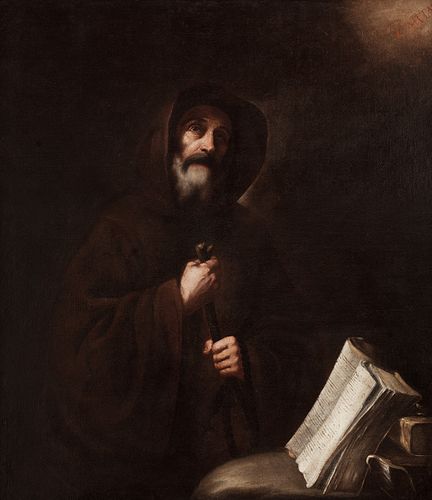Workshop of JOSÉ DE RIBERA (Xátiva, Valencia, 1591 - Naples, 1652). "St. Francis of Paula" ca.1630. Oil on canvas.
Lot 75
About Seller
Setdart Auction House
Carrer Aragó 346
Barcelona
Spain
Setdart Subastas was born in 2004 and is currently the first online art auction in Spain with solidity, prestige and reliability guaranteed by our more than 60,000 users. Setdart has a young, dynamic and enterprising team ready to successfully manage the purchase and sale of art works through custom...Read more
Estimate:
EUR€12,000 - EUR€15,000
$12,903.23 - $16,129.03
Absentee vs Live bid
Two ways to bid:
- Leave a max absentee bid and the platform will bid on your behalf up to your maximum bid during the live auction.
- Bid live during the auction and your bids will be submitted real-time to the auctioneer.
Bid Increments
| Price | Bid Increment |
|---|---|
| EUR€0 | EUR€10 |
| EUR€200 | EUR€25 |
| EUR€500 | EUR€50 |
| EUR€1,000 | EUR€100 |
| EUR€3,000 | EUR€200 |
| EUR€5,000 | EUR€500 |
| EUR€10,000 | EUR€1,000 |
| EUR€20,000 | EUR€2,000 |
| EUR€50,000 | EUR€5,000 |
About Auction
By Setdart Auction House
Oct 20, 2021
Set Reminder
2021-10-20 07:30:00
2021-10-20 07:30:00
America/New_York
Bidsquare
Bidsquare : OLD MASTERS
https://www.bidsquare.com/auctions/setdart-auction-house/old-masters-7700
Setdart Auction House sofia@setdart.com
Setdart Auction House sofia@setdart.com
- Lot Description
Workshop of JOSÉ DE RIBERA (Xátiva, Valencia, 1591 - Naples, 1652). "St. Francis of Paula" ca.1630. Oil on canvas. Size: 120 x 103 cm; 128 x 112 cm (frame). In this canvas is represented San Francisco de Paula of half body, in pensive position, with the glance directed upwards, in the direction of a halo of light that emanates from the top right part of the composition and in which the word "Caritas" can be read. He appears dressed in dark sackcloth, typical of his hermit character, accompanied by the staff, his main iconographic attribute, and with the Holy Scriptures in front of him, also illuminated by a spotlight that falls directly on them. It is a work perfectly framed within the naturalistic baroque, heir of José de Ribera, starring a totally earthly man, with a face far from any idealization. San Francisco de Paula is presented as a real person, with personalized features typical of the individualized study, furrowed by deep wrinkles. As usual within the naturalistic baroque, the composition is simple and clear, with the character in the foreground against a neutral and dark background that enhances his physical presence. Apart from the human model and this composition, the lighting is also clearly naturalistic, a tenebrism derived directly from Ribera that is based on an artificial, directed spotlight that penetrates the painting through the lower left corner and falls on the face and hands of the saint, also illuminating the writings and the table in the foreground, leaving the rest in a nuanced penumbra, very worked, as we can see in the perfectly achieved mantle, characterized by its realism, despite being enveloped in shadows. The chromatism is also typical of this school, very limited around the ochers, earthy, reflecting the warm and naturalistic atmosphere. Regarding the subject, it represents Saint Francis of Paola (Calabria, Italy, 1416-Tours, France, 1507), hermit founder of the Order of the Minims and saint of the Catholic Church in the Italian region of Calabria. Legend has it that St. Francis became seriously ill of the eyes, reason for which his parents entrusted themselves to St. Francis, curing their son's eyes. To be grateful for the miracle, at the age of fourteen he went on pilgrimage to Assisi, thus becoming a hermit. For five years he withdrew to the mountain, feeding only on water and wild herbs, sleeping on the hard ground, with a stone as a pillow. He was canonized in 1519, only twelve years after his death, during the pontificate of Pope Leo X. In the early years of the 16th century, the Order of the Minims entered Spain, acquiring great diffusion due to the values of Franciscan preaching that they spread, which, linked to the recent canonization of the saint and his way of life and poverty, strongly influenced the Spanish Christian population. Due to the aforementioned formal characteristics, this painting can be related to the circle of José de Ribera, a key painter for the development of the naturalistic baroque not only in Spain, but also in Italy and in other national schools, given the great diffusion of his work. Called the Españoleto, he was a key master of the Spanish Baroque, and in general of the history of art at the European level. Although no documentary sources or evidence of his youth are preserved, it is believed that he trained with Francisco Ribalta in Valencia, after which he went to Italy, first to the north and later to Rome, where he learned first-hand about the classicists and the Caravaggesque tenebrism of the Dutch who settled there. Finally he settled in Naples, where he arrived in 1616. Then began his period of maturity and splendor; Ribera enjoyed fame and a large workshop, and his works spread throughout Europe through engravings.
- Shipping Info
-
In-house shipping available. Please inquire at admin@setdart.com.
-
- Buyer's Premium



 EUR
EUR CAD
CAD AUD
AUD GBP
GBP MXN
MXN HKD
HKD CNY
CNY MYR
MYR SEK
SEK SGD
SGD CHF
CHF THB
THB











